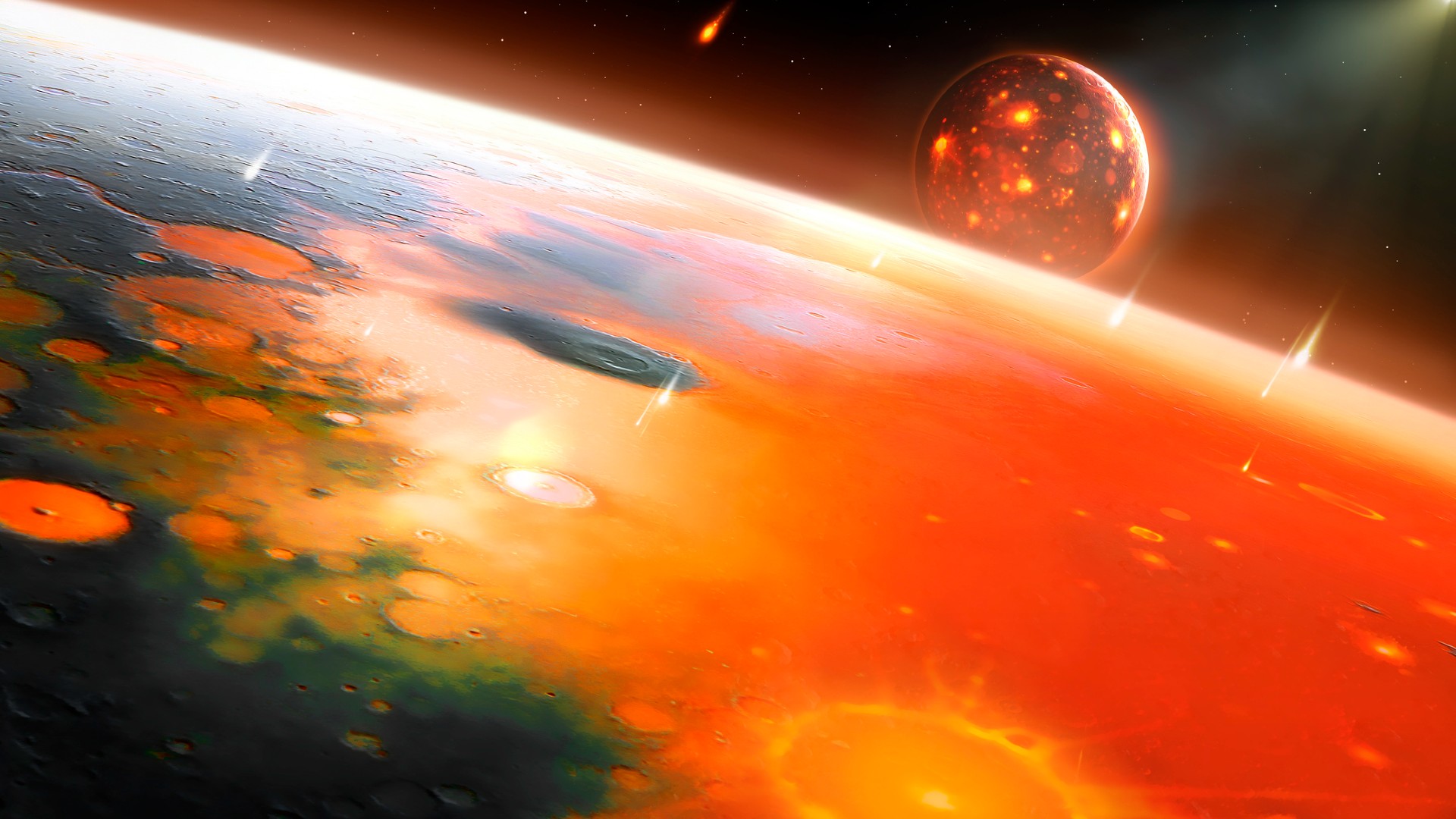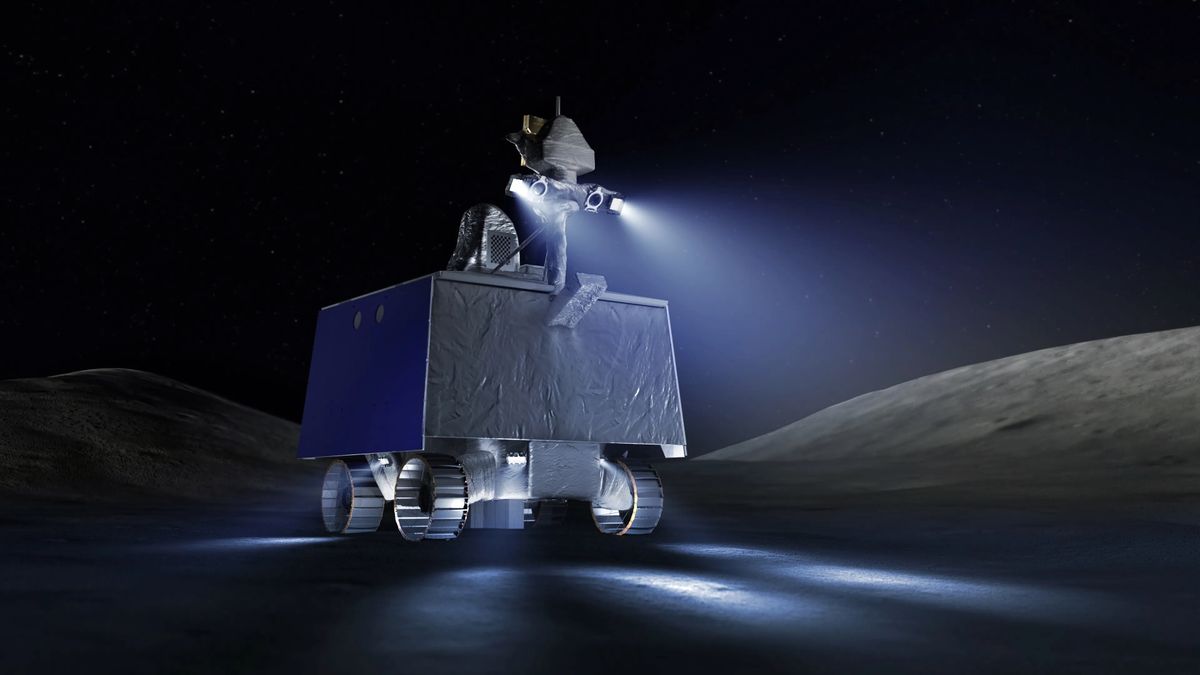The moon spent a few million years as a volcanic wasteland, covered with ongoing eruptions that spewed from mountains and even from the ground itself. New research suggests that the moon's orbit could have turned it into a molten monster for a few tens of millions of years. The result may have been comparable to Jupiter's moon Io, the most volcanic body in the solar system.
Early in the history of the solar system, a massive protoplanet plowed into a young Earth. The colliding material intermixed, then reformed into two separate bodies that would become Earth and the moon. The two orbited almost on top of one another, but over time, the moon slowly drifted away, solidifying as it went.
Eventually, the sun's gravity exerted a stronger pull on the moon. Although it was farther away than the sun, the two bodies tugged on the moon equally.
"The moon gets sort of confused," planetary scientist Francis Nimmo, of the University of California, Santa Cruz, told Space.com. "It doesn't know exactly what orbit it should be adopting, and so it can develop kind of a weird orbit." Nimmo presented the results of his study in March at the 56th annual Lunar and Planetary Sciences Conference.
The resulting gravitational mishmash churns up the lunar interior, melting rock to create a magma layer that erupts to the surface.
The new research suggests that the lunar surface may have been reset by the lava flows roughly 4.35 billion years ago. The lava flows would have filled in any existing craters and helped to reset the ages measured by moon rocks and lunar zircons.
Old versus young moon
Figuring out when the moon formed presents its own challenges. There are a number of methods, from studying samples returned to Earth to examining zircons within those rocks to trying to figure out how the planets and their satellites danced billions of years ago. But those methods can all give conflicting answers.
Probing the age of moon rocks was one of the first ways scientists attempted to calibrate the age of the moon. Samples brought back from NASA's Apollo progam were studied and measured. Today, new samples continue to come in, now from China's ongoing series of Chang'e program. These provide new objects to study and test.
A second line of evidence for the lunar age comes from zircons within the rocks themselves. Zircons are silicate minerals found inside of rocks on both Earth and moon and are some of the oldest objects in the solar system. While rocks can melt and reform, the zircons themselves are tough enough to resist melting at all but the highest temperatures.
"Zircons are very tough," Nimmo said. "It takes a lot to destroy a zircon once it's formed." Melting the lunar surface through extensive volcanism is one way to reset the zircons.
Both methods of dating can be a challenge. Zircons are more precise but require incredibly precise measurements, which is why scientists have only been able to examine them over the last two decades or so. Moon rocks, on the other hand, can be more complicated to interpret, and have been providing a variety of ages. Together, the two processes suggest the moon is about 4.35 billion years old.
Scientists also rely on insights from dynamical models. Studies of Earth show that it collected a lot of iron-loving metals after it had already formed an iron core. Those metals settled in the mantle, making up roughly a half of a percent of Earth's mass after core formation was completed, and are referred to as the Late Veneer. But those metals had to be absorbed while material was still flying around in the chaotic, cluttered early solar system — and 4.35 billion years ago, that material was already gone.
With the new results, published in the journal Nature at the end of last year, Nimmo and his colleagues are suggesting that a 4.5-billion-year-old moon would fit into measurements of younger lunar rocks. When the moon suffered from a tug-of-war between Earth and the sun, the melting would have caused lunar rocks and zircons to melt and reform, providing a younger age that doesn't necessarily reflect when the moon itself was born.
A lunar Io
For a few tens of millions of years, volcanism would have covered the moon. But it wouldn't necessarily have been expressed as massive spewing mountains. On Earth, volcanic material is rich in silicate, which thickens the lava and allows it to pile up into massive mountains. On the moon, the lava was likely thinner, seeping through the crust and out to the side rather than piling up on itself.
"There was certainly lots of volcanism, it just didn't really produce volcanoes that we're familiar with," Nimmo said.
The constant seepage may have inhibited the formation of a magma ocean layer because the newly formed liquid wouldn't remain stuck in the mantle. As the material melted and became buoyant, it would have oozed upward to the crust. Some of it would have broken through, but some of it may have simply filled in the crust, creating outward buckles like those seen on Earth.
At the time, the Earth would have been far closer to the moon than it is today, making it perhaps twice as large in the lunar sky as it is today. "You would see glowing lava flows all over the place, and maybe the odd volcanic eruption," Nimmo said.
The Io-like state would have only lasted maybe a few tens of millions of years, according to Nimmo.
"This was kind of a brief but very energetic event," he said.








 English (US) ·
English (US) ·